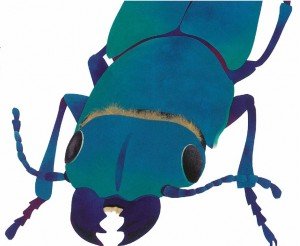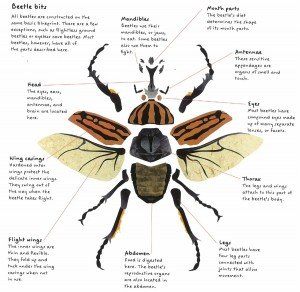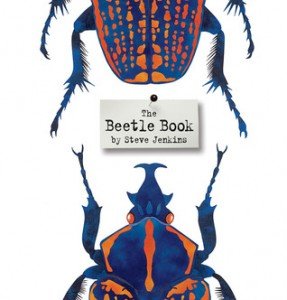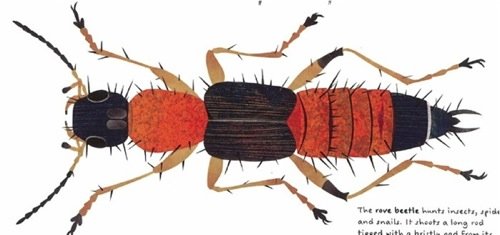I have late adult-onset beetle fever. Actually, it is the weevil (with their admirable snouts) who really rock my boat, but any beetle will do. I used to be scared of beetles, bees, and buggery of any sort, but now I am pleased to report that I live in amiable companionship with all insects. Must be the walking. After 17 years of tramping around the ravines and trails of my city, I’ve learned to be at home with the tiny lives that populate the world in numbers far greater than human.
As a sometime illustrator, bugs (as a subject matter) are about as good as it gets, and I believe Steve Jenkins would agree. In The Beetle Book, Jenkins is clearly besotted with all one million of the species, 650,000 of which have yet to be named. According to Jenkins, if you lined up every kind of plant and animal on earth, “…one in every four will be a beetle.” That’s a lot of beetles, and while only a few if these (comparatively speaking) are included in The Beetle Book, the variation in size, colour and design is truly remarkable. And in Jenkins hands, these little, and sometimes not so little guys are works of art. Works of art with antennae. Hey, one man’s antennae is another man’s haystack. Step aside, Mr Monet.
 The Beetle Book is both a comprehensive introduction to this omnipresent insect and a celebration of the complexity and beauty of nature. Each two-page spread discusses a different aspect of beetleology under headings such as Beetle Senses, Beetles Big and Little, and Chemical Warfare. Did you know the bombardier beetle can squirt a “…blinding, boiling hot liquid into the face of an attacker?” Impressive. Also impressive is the variation in size. The clown beetle is no bigger than a dot, while the African goliath beetle is the size of a human hand and is sometimes kept as a pet. If the goliath had the skills of the bombardier, it would make a very effective guard beetle, or maybe even a new form of police taser. I imagine the very idea of being shot in the face with noxious fluids from a beetle would be a deterrent to crime. In any case, Jenkins manages to keep the tone light and engaging, while imparting a significant amount of information, all of it fascinating.
The Beetle Book is both a comprehensive introduction to this omnipresent insect and a celebration of the complexity and beauty of nature. Each two-page spread discusses a different aspect of beetleology under headings such as Beetle Senses, Beetles Big and Little, and Chemical Warfare. Did you know the bombardier beetle can squirt a “…blinding, boiling hot liquid into the face of an attacker?” Impressive. Also impressive is the variation in size. The clown beetle is no bigger than a dot, while the African goliath beetle is the size of a human hand and is sometimes kept as a pet. If the goliath had the skills of the bombardier, it would make a very effective guard beetle, or maybe even a new form of police taser. I imagine the very idea of being shot in the face with noxious fluids from a beetle would be a deterrent to crime. In any case, Jenkins manages to keep the tone light and engaging, while imparting a significant amount of information, all of it fascinating.
Having spent my entire childhood terrified of anything that crawled, skittered, or buzzed, a book like this goes a long way to ameliorate the fear of beetles, and bugs in general, and may even ignite an interest in the entomological wonders crawling,  skittering and buzzing all around us. At the very least, Jenkins’ torn and cut paper collage illustrations of these naturally bejeweled critters are superb, which makes The Beetle Book worth investigating, even if you’re not inclined to investigate actual beetles. Many of the insects depicted in the book are life-size, and frankly, I’d rather look at a pretty picture of the giant Fijian long-horn beetle than see one in person, although I’m sure they’re fine fellows in their own, highly evolved way.
skittering and buzzing all around us. At the very least, Jenkins’ torn and cut paper collage illustrations of these naturally bejeweled critters are superb, which makes The Beetle Book worth investigating, even if you’re not inclined to investigate actual beetles. Many of the insects depicted in the book are life-size, and frankly, I’d rather look at a pretty picture of the giant Fijian long-horn beetle than see one in person, although I’m sure they’re fine fellows in their own, highly evolved way.
In researching this post, I was astonished to read that Jenkins primary medium is collage. This sent me back to The Beetle Book for another, closer look. Like the beetle, this talented artist is in possession of some mad skills. Without losing the rich textures of the various papers, or their cut and torn edges, Jenkins manages to make his collages look like paintings. It is a beautiful book, and beetles everywhere are rejoicing. Or clicking. Or hissing, as befits the species.
Steve Jenkins was born in Hickory, North Carolina in 1952. Although initially interested in becoming a scientist, Jenkins studied graphic design at university, eventually writing and illustrating many acclaimed books on science and nature, some of which were inspired by conversations with his three children.What Do You Do with a Tail Like This?  illustrated and written by Steve Jenkins and Robin Page (his wife and sometime collaborator) was awarded the Caldecott honour in 2004. Mr Jenkins and his family currently reside in Boulder, Colorado, home to many varieties of beetle, or so I’m lead to believe.
illustrated and written by Steve Jenkins and Robin Page (his wife and sometime collaborator) was awarded the Caldecott honour in 2004. Mr Jenkins and his family currently reside in Boulder, Colorado, home to many varieties of beetle, or so I’m lead to believe.
The Beetle Book by Steve Jenkins. Published by Houghton Mifflin, 2012. ISBN: 978-0547680842


I love it! Beetles are my favorite, and these are beautiful.
I would like to see one of YOUR bugs, Storygirl!